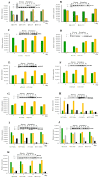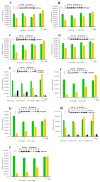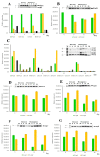High-Light-Induced Degradation of Photosystem II Subunits' Involvement in the Albino Phenotype in Tea Plants
- PMID: 35955658
- PMCID: PMC9369412
- DOI: 10.3390/ijms23158522
High-Light-Induced Degradation of Photosystem II Subunits' Involvement in the Albino Phenotype in Tea Plants
Abstract
The light-sensitive (LS) albino tea plant grows albinic shoots lacking chlorophylls (Chls) under high-light (HL) conditions, and the albinic shoots re-green under low light (LL) conditions. The albinic shoots contain a high level of amino acids and are preferential materials for processing quality green tea. The young plants of the albino tea cultivars are difficult to be cultivated owing to lacking Chls. The mechanisms of the tea leaf bleaching and re-greening are unknown. We detected the activity and composition of photosystem II (PSII) subunits in LS albino tea cultivar "Huangjinya" (HJY), with a normal green-leaf cultivar "Jinxuan" (JX) as control so as to find the relationship of PSII impairment to the albino phenotype in tea. The PSII of HJY is more vulnerable to HL-stress than JX. HL-induced degradation of PSII subunits CP43, CP47, PsbP, PsbR. and light-harvest chlorophyll-protein complexes led to the exposure and degradation of D1 and D2, in which partial fragments of the degraded subunits were crosslinked to form larger aggregates. Two copies of subunits PsbO, psbN, and Lhcb1 were expressed in response to HL stress. The cDNA sequencing of CP43 shows that there is no difference in sequences of PsbC cDNA and putative amino acids of CP43 between HJY and JX. The de novo synthesis and/or repair of PSII subunits is considered to be involved in the impairment of PSII complexes, and the latter played a predominant role in the albino phenotype in the LS albino tea plant.
Keywords: Camellia sinensis; albino tea; photodamage; photosystem II; thylakoid.
Conflict of interest statement
The authors declare no conflict of interest.
Figures






Similar articles
-
The light-harvesting chlorophyll a/b-binding proteins of photosystem II family members are responsible for temperature sensitivity and leaf color phenotype in albino tea plant.J Adv Res. 2024 Dec;66:87-104. doi: 10.1016/j.jare.2023.12.017. Epub 2023 Dec 25. J Adv Res. 2024. PMID: 38151116 Free PMC article.
-
Shading-Dependent Greening Process of the Leaves in the Light-Sensitive Albino Tea Plant 'Huangjinya': Possible Involvement of the Light-Harvesting Complex II Subunit of Photosystem II in the Phenotypic Characteristic.Int J Mol Sci. 2023 Jun 18;24(12):10314. doi: 10.3390/ijms241210314. Int J Mol Sci. 2023. PMID: 37373460 Free PMC article.
-
Significantly increased amino acid accumulation in a novel albino branch of the tea plant (Camellia sinensis).Planta. 2019 Feb;249(2):363-376. doi: 10.1007/s00425-018-3007-6. Epub 2018 Sep 12. Planta. 2019. PMID: 30209617
-
Towards a critical understanding of the photosystem II repair mechanism and its regulation during stress conditions.FEBS Lett. 2013 Nov 1;587(21):3372-81. doi: 10.1016/j.febslet.2013.09.015. Epub 2013 Sep 19. FEBS Lett. 2013. PMID: 24056074 Review.
-
Thylakoid protein phosphorylation in dynamic regulation of photosystem II in higher plants.Biochim Biophys Acta. 2012 Jan;1817(1):232-8. doi: 10.1016/j.bbabio.2011.05.005. Epub 2011 May 14. Biochim Biophys Acta. 2012. PMID: 21605541 Review.
Cited by
-
Integrated Transcriptomic and Metabolomic Analyses Shed Light on the Regulation of Aromatic Amino Acid Biosynthesis in a Novel Albino Tea (Camellia sinensis) Mutation.Curr Issues Mol Biol. 2025 Aug 12;47(8):644. doi: 10.3390/cimb47080644. Curr Issues Mol Biol. 2025. PMID: 40864798 Free PMC article.
-
Metabolic and Transcriptomic Profiling Reveals Etiolated Mechanism in Huangyu Tea (Camellia sinensis) Leaves.Int J Mol Sci. 2022 Nov 30;23(23):15044. doi: 10.3390/ijms232315044. Int J Mol Sci. 2022. PMID: 36499369 Free PMC article.
-
The light-harvesting chlorophyll a/b-binding proteins of photosystem II family members are responsible for temperature sensitivity and leaf color phenotype in albino tea plant.J Adv Res. 2024 Dec;66:87-104. doi: 10.1016/j.jare.2023.12.017. Epub 2023 Dec 25. J Adv Res. 2024. PMID: 38151116 Free PMC article.
-
Shading-Dependent Greening Process of the Leaves in the Light-Sensitive Albino Tea Plant 'Huangjinya': Possible Involvement of the Light-Harvesting Complex II Subunit of Photosystem II in the Phenotypic Characteristic.Int J Mol Sci. 2023 Jun 18;24(12):10314. doi: 10.3390/ijms241210314. Int J Mol Sci. 2023. PMID: 37373460 Free PMC article.
-
Exploring the RNA Editing Events and Their Potential Regulatory Roles in Tea Plant (Camellia sinensis L.).Int J Mol Sci. 2022 Nov 7;23(21):13640. doi: 10.3390/ijms232113640. Int J Mol Sci. 2022. PMID: 36362430 Free PMC article.
References
-
- Du Y.Y., Liang Y.R., Wang H., Wang K.R., Lu J.L., Zhang G.H., Lin W.P., Li M., Fang Q.Y. A study on the chemical composition of albino tea cultivars. J. Hortic. Sci. Biotech. 2016;81:809–812. doi: 10.1080/14620316.2006.11512142. - DOI
-
- Shin Y.H., Yang R., Shi Y.L., Li X.M., Fu Q.Y., Lu J.L., Ye J.H., Wang K.R., Ma S.C., Zheng X.Q., et al. Light-sensitive albino tea plants and their characterization. Hortscience. 2018;53:144–147. doi: 10.21273/HORTSCI12633-17. - DOI
MeSH terms
Substances
Grants and funding
LinkOut - more resources
Full Text Sources

